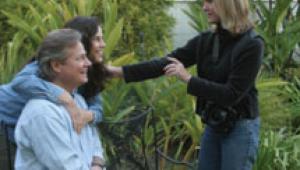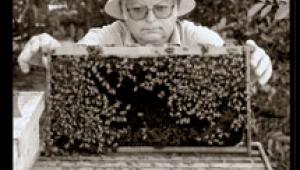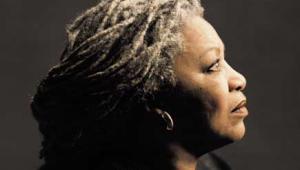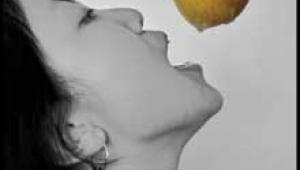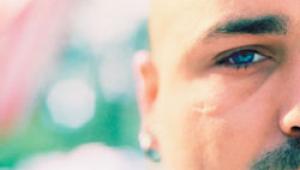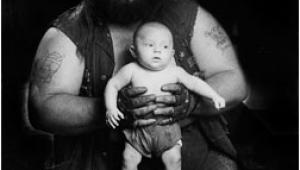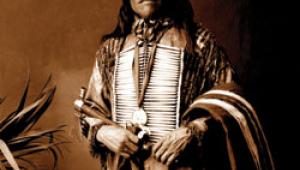Lara Jo Regan: A Strange and Beautiful Journey Page 2
After graduating from college, Regan moved to New York City and got her first job as a curatorial photographer for the Museum of Natural History. (She got Margaret Mead's former office at the museum.) She later dated a film editor during her mid-twenties, and followed him to Los Angeles. Although she was originally interested in writing screenplays with her brother, she wound up shooting still photography on the set of low-budget films made by producer/director Roger Corman. She did double-duty in "craft services," which involved cooking and serving food to the cast. "I was like a switch-engine. At the end of the day, I shopped for 60 people and made food for the following day."
 |
|
|
Regan developed two portfolios around
this time, one of photojournalism and one of "conceptual portraiture,"
which included Hollywood stars. She landed free-lance work with the Los Angeles
Reader and L.A. Weekly, two alternative newspapers. She also did some photography
for Venice magazine, "which paid nothing, but gave me access to celebrities."
She took her portfolio to New York City and visited Entertainment Weekly, which
was just getting its start, and the photo editor was impressed by her work.
She also joined a fledgling agency called Saba. "It was the coolest agency;
they represented photojournalists who shot pictures in a personal way."
Marcel Saba, also new to the industry, commented on how much he liked her style
and asked her if she knew lighting. "I bluffed and said that I did,"
she laughs, adding that she learned it as time went on.
In a few years, Regan's images of the Rodney King riots were published
in Newsweek, and her photos began to appear regularly in Time, Newsweek, Business
Week, and Entertainment Weekly. Charlie Holland, editor of Premiere magazine,
also utilized her talents for her "reportage" style. For four years,
she was the only photographer who was invited backstage at the Academy Awards.
"I had amazing access," she says, "but there was very little
space to work in, and it was hard to be spontaneous." Regan also found
that she disliked the politics of celebrity photography. "I wanted to
show truthful moments, but it was very difficult."
Beyond Myths
After four years of photographing celebrities backstage, she had a major exhibit
of her behind-the-scenes Oscar photos. (Regan also took behind-the-scenes images
at sitcoms, auditions, and pornographic films.) "I went through a stage
where I wanted to de-mythologise the glossy image of America that was perpetuated
by the mass media, entertainment and advertising cultures. I wanted to capture
truth," she says, which she found far more complex and fascinating. She
continued to take pictures of Hollywood events and people, but "got tired
of the politics."
 |
|
|
In the late '90s, LIFE magazine
gave her an assignment to photograph a story entitled "The Uncounted,"
about immigrants and people so poor that they were overlooked by the U.S. Census.
She embraced this project because "It gave me an opportunity to document
a part of the culture that existed outside the myth of America." Regan
traveled widely throughout the country on this assignment, as well as for some
of the other stories she documented. "The Uncounted" took about
a year for her to complete. "It was one of LIFE's last big commissions
before they ceased publication." She also received one of her industry's
top honors for this project as the recipient of the World Press Photo of the
Year in 2000, for her image of a poverty-stricken Mexican family in Texas. "I
was shocked that this particular photo won, because World Press usually picks
more action-oriented images," she says.
Regan decided to "paint a microcosm of America by documenting the inhabitants
of one demographically diverse California street" in her "American
Street" project, which is also a portrayal of "people's non-public
lives." A project in progress, her images provide a uniquely stark view
of people in their homes, revealing much about them and their lifestyles ("Our
home is like a museum and we're the curator"). To begin this personal
project, she says, she literally "knocked on people's doors,"
and some of her subjects referred her to others. "It was amazing, but
almost everyone said yes," she says. "This is the biggest project
I've ever undertaken."
Several years ago, Los Angeles magazine published a 16-page spread of the 17
"American Street" images Regan had completed. She also interviewed
all the families she photographed. According to Regan, "I'd like
to shoot about 10 more photos in the series." However, this project was
shelved about six years ago when fate intervened and changed the course of her
work.
 |
|
|
A Stray Becomes a Star
At this point, Regan was still regularly doing assignment photography for magazines
like Newsweek and Time. "I just remember driving a lot," she recalls.
At about 11 p.m. one such night, she got lost outside of Bakersfield, California,
after shooting a story on welfare mothers. She turned her car around near some
railroad tracks, "and saw a dog in the glow of my headlights." Realizing
it was abandoned and badly abused, her first concern was to get him out of the
street. "He literally limped into my arms." Although she says she
was an avowed cat lover up to that point, she nursed the tiny dog back to health
over the following year. "And I've been his personal slave ever
since."
The former stray soon became a star. Regan discovered that whenever she took
Mr. Winkle on walks, people marveled over the pint-sized wonder. He constantly
drew crowds who puzzled over what he could be: A toy? A cat in a dog suit? "As
time went on, I realized there's lots of pictures of animals, but there
could only be one Mr. Winkle. He seems to know that bringing happiness to others
is his life's goal."
"Dogs love to have a job," observes Regan, "and Winkle seems
to know it's his mission to pose." Noted photographer William Wegman
began photographing his Weimaraner, she points out, after the dog started following
him around the house. "It was clear to Wegman that the dog wanted to be
photographed." Although she mostly shot environmental portraits before
Mr. Winkle came along, today she typically photographs him in her at-home studio
in numerous guises, ranging from an angel to a gargoyle in Regan's "What
Is Mr. Winkle" series.
 |
|
|
Once his Website (www.mrwinkle.com)
went live in 2000, Regan says, everything broke loose. "I started out
with just one poster, calendar and a greeting card." Today, Mr. Winkle
has his own line of cards with Portal Publications, three books published by
Random House, best-selling calendars in their fourth year, and a line of additional
popular Mr. Winkle products on the Website. She takes Mr. Winkle to standing-room-only
appearances at bookstores around the country, and he's even been a guest
star on Sex in the City, as well as appearing on CNN and The Rosie O'Donnell
Show.
"Some people believe that he's the poster child for all the needy
animals in the world. People project a lot on him," Regan explains. (She
also donates proceeds from some of Winkle's merchandise sales to several
animal charity organizations.) "As a photographer and as one lucky enough
to have him in my life, I feel I need to share him with the world," she
says. Regan also maintains that she performs "A balancing act in not selling
him out. It's more of a personal thing, sharing my love for Mr. Winkle
and all the joy he brings me with everyone. "
In terms of camera equipment, Regan keeps it simple.
She does her 35mm work with either a Nikon N90s or an N8008. She also shoots
in medium format for formal portraits and calendar work. "The first Mr.
Universe sold me my Hasselblad years ago," she says. Although some of
the Mr. Winkle photos look as though she works extensively with Photoshop, she
really only uses this software "for refinements in the final image."
Influences
Regan admires the work of Annie Liebowitz because "She really does research
on her subjects and is a former photojournalist, which gives her work another
dimension." Other favorites include Dan Winters, "who does cool,
wildly original portraits of celebrities"; Irving Penn because "His
portraits were so profound--he realized when someone's soul was being
revealed, and knew just when to click the shutter"; and Mary Ellen Mark:
"I can tell by her work that she's truly interested in her subjects."
Regan adds, "What they all seem to have in common is that they seem to
have a genuine passion for their subjects and a reverence for revealing truth."
She's placed photojournalism on hold for the time being "Because
the world will always be there." For now, she's completing work
on a Mr. Winkle 2005 calendar, and has plans to do more books, including one
called "Letters to Mr. Winkle," based on fan letters and e-mail.
No one is more surprised than Regan at the road her career has taken. "It's
been a strange and beautiful journey," she concludes.
- Log in or register to post comments
